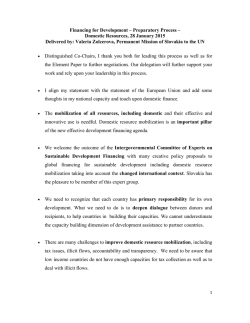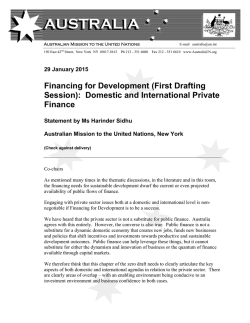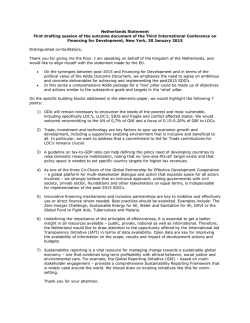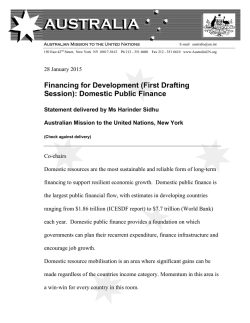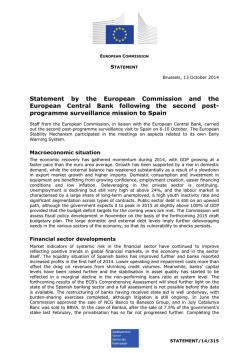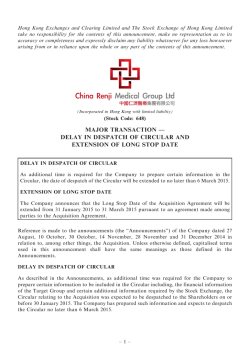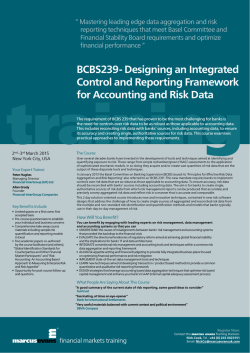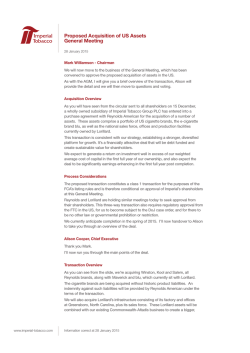
Rosof, Eric M. et al "Acquisition Financing: the Year Behind and the
Wachtell Lipton discusses Acquisition Financing By Eric M. Rosof, Joshua A. Feltman, Gregory E. Pessin, Michael S. Benn and Austin T. Witt February 3, 2015 Acquisition financing activity was robust in 2014, as the credit markets accommodated increased demand from rising M&A activity. At over $749 billion, global 2014 M&A loan issuance was up approximately 40 percent year over year, the highest total since before the Great Recession. While the aggregate figures suggest a borrower-friendly market, the actual picture is more nuanced. Investment grade acquirors benefited from a consistently strong financing environment throughout 2014 and finished the year with a flourish (including a $36 billion commitment backing Actavis’ acquisition of Allergan), while leveraged acquirors encountered more volatility, as lenders responded quickly to regulatory changes and market conditions, and both high-yield commitments and debt became more costly. While our memos of January 31, 2013 and January 31, 2014 have emphasized market responses to a stable, extended period of historically low interest rates – including expanding leverage multiples and borrower-friendly contractual terms foisted upon yield-seeking investors – 2014 was notable for governmental action, on both the regulatory and monetary policy fronts. Regulatory Policy and Acquisition Financing More demanding capital and liquidity requirements for banks resulting from Dodd Frank and Basel III were finalized in 2014, and will be phased in over the next few years. Further, the primary US bank regulators, including the Federal Reserve, the Office of the Comptroller of the Currency and the FDIC, continued to criticize leveraged lending practices directly, pushing harder on their 2013 guidance. Public enforcement actions for violations of the 2013 guidance have yet to be imposed on any institution. However, the Fed has warned banks that high levels of leveraged lending may adversely impact the Fed’s consideration of the annual stress tests. A failing grade on the stress tests can constrain a bank’s ability to pay dividends, so passing them is of critical importance. On the other hand, fears of bright-line prohibitions on deals with leverage above 6 times the borrower’s annual EBITDA and/or requirements that borrowers have sufficient cash flow to fully amortize debt over a specified period are not expected to be realized. Lenders’ concerns with the impact of capital requirements and the regulatory attention to leveraged lending likely played at least some role in the lackluster numbers for private-equity driven take-private transactions in 2014 (just 2 transactions with values over $5 billion as compared with 20 such transactions in 2007). But more interesting is the manner in which the deals that signed got done. A number of developments merit mention and bear watching in 2015: First, the rise of financing commitments from non-bank sources, as traditional lenders exercised caution on highly levered transactions. Several major banks were reported to have declined to underwrite Vista Equity’s 2014 acquisition of TransFirst for fear of regulatory fallout due to the reportedly high proposed leverage. Instead, the sponsor obtained the funding from non-banks Jefferies, Guggenheim, Apollo and Vista’s own credit fund, as well as non-US-deposit-taker Nomura. In May, Jefferies led a group of foreign banks, including Nomura and Macquarie, in financing Brickman’s acquisition of Valleycrest, while several major banks that had financed KKR’s acquisition of Brickman less than a year earlier were notably absent. Given the regulatory scrutiny (which banks have been warned will be “deal by deal”), the increasing importance of non-bank asset managers in all stages of the financing market, from commitment through syndication, will surely continue. A retreat from the market by large balance sheet banks could have a lasting impact on both deal activity and deal structures premised on committed financing. Second, the rise of the pre-funded term loan. Since 2008, bridge loan commitments on high yield names have often permitted underwriters to cause borrowers to issue notes into escrow prior to closing transactions, and thus eliminate the capital markets risk of having to fund a bridge loan at closing. Last year, we witnessed the growth of analogous mechanics for term loan commitments in response to more stringent capital requirements, as well as, in some cases, voluntary decisions by borrowers (including Burger King Worldwide in connection with its acquisition of Tim Hortons) to go to market on loans ahead of transaction closings. Lenders have adopted a variety of approaches to reduce their risk and capital burden in advance of closing, from relatively pedestrian “ticking” fees (to compensate the bank for the capital costs of holding open commitments) to imposing full-blown interest costs, and may even seek to require funding loans prior to closing (allowing underwriters to sell the debt, offload the risk and eliminate the capital charge altogether). Third, increasing capital burdens with respect to unfunded commitments have affected banks’ attitudes towards not only acquisition financing, but also revolving loan facilities, a more permanent sort of unfunded/partially funded (if all goes well) lending commitment. In the high yield market, financing package negotiations have increasingly involved fixing and allocating term loan and bond underwriting fees on the basis of banks’ willingness to accept revolver commitments. Moreover, traditionally, the “lead left” bank in a syndicate, even a syndicate including several of the largest banks, has taken the role of issuer of letters of credit and provider of “swingline” borrowings under the revolver. Over the last year, lead banks negotiated more heavily to spread this obligation and the associated capital burden, an inconvenience for corporate treasury departments accustomed to dealing with a single institution on these fronts. One upshot of the resistance to providing revolving commitments has been increased bias toward alternative forms of working capital financing – asset-backed, factoring and receivables securitization facilities – in lieu of cash flow revolvers, even though such structures are generally less favorable to term loan lenders. We expect this trend to continue. Regulatory action affecting acquisition finance in 2014 was not limited to policies directed at bank safety and soundness. For example, the US Treasury issued a notice in September describing forthcoming regulations relating to so-called “inversion” transactions, which will make it more costly for US companies to use off-shore cash as a source of financing for combinations structured as a reincorporation into a non-US jurisdiction. In addition, the FDIC adopted final rules implementing credit risk retention for asset-backed securities, including “skin in the game” requirements that CLO managers retain 5% of the fair value of the liabilities of the CLO. In advance of these rules becoming effective, CLO managers significantly increased their investment activity in 2014, with annual CLO volume up approximately 50 percent over 2013 to more than $120 billion. Going forward, the rules may reduce the liquidity provided by CLO funds for financing acquisitions, and are generally expected to favor the interests of the larger and more diversified asset managers that sponsor CLOs. Monetary Policy and Acquisition Financing The Federal Reserve tapered and ultimately terminated its quantitative easing program in 2014, and set expectations that interest rates will rise in 2015, while still maintaining its customary inscrutability on the details. The resulting uncertainty seemed to have a greater impact on the high yield market, which became more volatile, with market windows opening and shutting more frequently as the year drew to a close. The record investment grade deal activity may have been driven by buyers not wanting to miss out on the historic opportunities for large bracket acquisitions funded with cheap debt. A related divergence between US and non-US central bank policies, particularly towards the end of 2014, created opportunities to borrow in euro and other foreign currencies at favorable rates compared to the dollar. Both investment grade and high yield acquirors with significant non-US revenue streams, providing a natural currency hedge, took advantage by increasing their non-dollar borrowings to finance acquisitions: on the high-grade side, Walgreens Boots Alliance issued dollar, euro and sterling bonds to finance its purchase of the remaining 55% of Alliance Boots, while on the high-yield side, Constellium issued both dollar and euro notes in connection with its acquisition of Wise Metals. We expect this trend to continue as the U.S. economy appears to be strengthening, while the European Central Bank appears set for a major round of economic stimulus (i.e., bond buying) in coming weeks and months. * * * How banks ultimately adjust to higher capital costs for, and greater regulatory scrutiny of, acquisition financing commitments is an open question. While the market is already responding, larger high-yield deals – particularly those requiring greater lead-time to close – may become harder to finance, and the advantages of high-grade acquirors in cash acquisitions may be accentuated. For now, while the shifting landscape may require new ways of doing deals, quick footedness in seizing windows of opportunity, and creative ways to balance the new costs and risks, the credit markets are well positioned to provide strong support for deal-making in 2015. With strengthened balance sheets following years of European financial turmoil, non-US banks have returned as strong participants in deal finance. Defaults and restructurings remain historically low. Fixed income investors continue to have a huge appetite for product, making new funds available. Flights to safety continue to keep long term rates in check. The year ahead looks challenging, and more volatile than the year behind, but is likely to afford ample opportunity to deploy debt to finance acquisitions. The full and original memorandum was published by Wachtell, Lipton, Rosen & Katz on January 22, 2015.
© Copyright 2025
